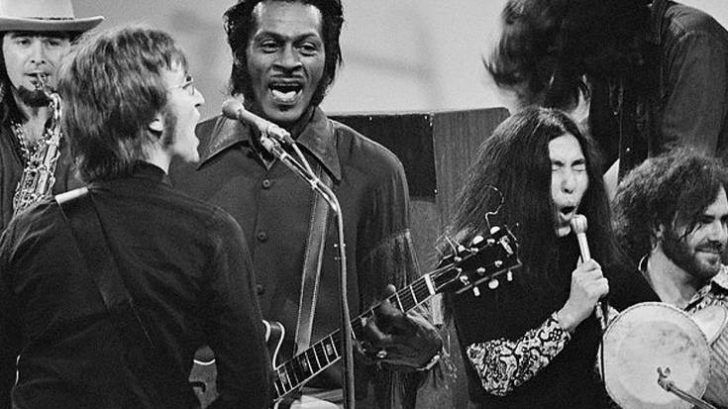Rock and roll is one of the most influential music genres of all time, but there are still some hidden facts that fans may not be aware of. Here are 12 of the most interesting facts about rock and roll history that you may not know:
Sister Rosetta Tharpe: The Godmother of Rock and Roll
Sister Rosetta Tharpe, a gospel singer, guitarist, and songwriter, paved the way for rock and roll music with her innovative use of the electric guitar. She was the first to incorporate distortion, heavy amplification, and other effects into her guitar playing. She also helped to bridge the gap between gospel and secular music and influenced many of rock and roll’s biggest names.
Chuck Berry: The Father of Rock and Roll
Chuck Berry, known for hits like “Johnny B. Goode” and “Maybellene,” is widely regarded as the father of rock and roll. His energetic guitar playing, clever lyrics, and showmanship set the standard for the genre and influenced countless musicians to come.
Lead Belly: The Prisoner Who Sang His Way to Freedom
Lead Belly, a blues and folk musician, was imprisoned for attempted murder in the early 1900s. Legend has it that he wrote a song for the governor, which helped win his release. He allegedly repeated the feat years later after being imprisoned again, proving the power of music to overcome even the most difficult circumstances.
The Many Meanings of Rock and Roll
Before becoming a music genre, “rock and roll” had many different meanings, including dancing, partying, and sex. It was originally used to describe the motion of a ship at sea, which was later adapted to describe the rhythm and energy of early rock music.
The Rolling Stones: Inspired by an Indian Goddess
The Rolling Stones’ famous tongue logo was inspired by the Hindu goddess Kali, who is often depicted with a long, protruding tongue. The logo was designed by artist John Pasche, who was studying at the Royal College of Art in London at the time.
Stevie Nicks: The Queen of Rock and Roll
Stevie Nicks, known for her solo work and as the lead singer of Fleetwood Mac, is the only woman to be inducted into the Rock & Roll Hall of Fame twice. She was first inducted as a member of Fleetwood Mac in 1998 and then again as a solo artist in 2019.
Queen: The Longest-Running Fan Club in Rock and Roll History
Queen’s fan club, which was founded in 1974, is still active today and is the longest-running fan club in rock and roll history. It has more than 20,000 members from all over the world and is known for its extensive archive of Queen memorabilia.
Elvis Presley: Burned in Effigy
After his controversial performance on “The Ed Sullivan Show” in 1956, Elvis Presley was burned in effigy by some religious groups who were outraged by his suggestive dance moves and provocative lyrics. The incident only added to his legend and helped to solidify his status as the King of Rock and Roll.
Wabash Cannonball: The Earliest Influences on the Rock Genre
“Wabash Cannonball,” a song first recorded in 1882, is considered one of the earliest influences on the rock genre. The song’s upbeat tempo, driving rhythm, and catchy melody helped set the stage for the music that would come decades later.
Sympathy for the Devil: Inspired by French Poet Baudelaire
Mick Jagger’s famous song “Sympathy for the Devil” is believed to be inspired by the French poet Charles Baudelaire. The song’s lyrics reference many historical events, including the Russian Revolution and the Kennedy assassination, but the overall message is one of sympathy for the devil and a belief in the duality of good and evil in human nature. Some fans have even speculated that the song was written from the perspective of Lucifer himself, presenting a devilish voice that takes the listener on a tour of human history.
The “Devil Horns”
The first rocker to use the “devil horns” salute is up for debate: The “devil horns” gesture, which involves holding up the index and pinky fingers while tucking in the middle and ring fingers, has become synonymous with rock and roll. Some credit Ronnie James Dio, the legendary frontman of bands like Black Sabbath and Dio, with popularizing the gesture. Dio claimed to have learned the gesture from his Italian grandmother, who used it to ward off the evil eye. However, others have pointed to earlier examples of musicians using similar hand gestures, including Gene Simmons of Kiss and John Lennon of The Beatles.
Frank Sinatra’s Controversial Views on Rock Music: A ‘Rancid-Smelling Aphrodisiac’ Played By ‘Cretinous Goons’
Frank Sinatra said rock was a “rancid-smelling aphrodisiac” played by “cretinous goons”: The Chairman of the Board wasn’t exactly a fan of rock and roll. In a 1957 interview with Playboy, Frank Sinatra famously dismissed the genre as “the most brutal, ugly, desperate, vicious form of expression it has been my misfortune to hear.” He went on to describe rock as a “rancid-smelling aphrodisiac” played by “cretinous goons.” Of course, Sinatra’s opinion didn’t stop rock and roll from taking over the world in the decades that followed.

